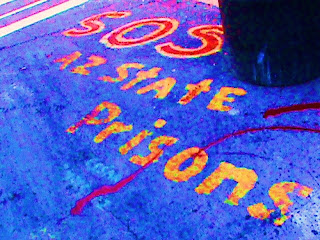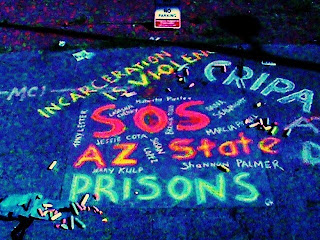UPDATED 2/2/2012:
The answers to those of my questions below which can be derived from criminal and court records are in this new article by the Arizona Republic.
I'm choosing not to re-print it here because the article positions
Forrest's behavior problems in a way that seems to justify her being
sent to prison in the first place...like she was just a "bad girl". I
don't accept that premise. She acted out the way children do when
troubled...and troubled children, in my book, do not belong in adult
prison.
So,
if you plan to contact either the judge or prosecutor in this case, do
check out the AZ Republic article linked to above to see just the
surface of what they were looking at, through the eyes of the criminal
justice system. Before you make up your mind what to write, though, read
the note below from this friend of Forrest's family as well...
UPDATED (9/31/12):
At the age of 16, despite being too young to be trusted to drink, drive, smoke, vote, or even get away with skipping school, Forrest Day was prosecuted as an adult
for the death of her 8 month old baby. As recounted in the article
below, she put her son in the bathtub then got distracted elsewhere in
the house by writing poetry - behavior characteristic of a child. It's
not even as if she went out partying and left him home alone, beat or
shook him, or even filled up the tub.
It doesn't
appear that Forrest was even accused of intending to hurt her child.
You don't have to will a person harm in order to be charged with
negligent homicide, of course, though I suspect they hit her so hard to
begin with in order to coerce her into a plea deal on the felony child
abuse charges - which I also think were a stretch in this circumstance.
This case may not be entirely a matter of Andrew Thomas' office overreaching again, though. It looks like the state law requires prosecutors to file charges in adult court when certain felonies and violent crimes are involved - when that happens, though, it appears as if that court then has discretion over where the case is heard.
In any event, Forrest's prosecutor was Suzanne E. Cohen. Her office with the Maricopa County Attorney is at: 301 W. Jefferson St., Phoenix, AZ 85003.
She's just applied to be nominated as a judge,
so this would be a good time to write to her about her take on charging
children like Forrest as adults (according to the DOJ's research, it doesn't reduce crime). She just helped prosecute the Baseline Killer
and got a few death sentences, so there's a good chance she could end
up on the Superior Court bench in the next couple of years.
Forrest was sentenced to probation, and then to prison, by Michael Kemp,
a judge from Juvenile Court. I can't tell from the records who actually
made the decision to let the state prosecute her as an adult, though.
If you have questions about why he did what he did and what he thinks
about charging children like her as adults - kids with no criminal
record or intent - direct them to him. He can be reached at:
Northwest Regional Center (NW)
14264 W. Tierra Buena Lane
Surprise, AZ. 85374
(602) 372-9400
For
those of you who have never been on probation or parole, it's not as
easy as you may think to abide by. Forrest violated hers within a year,
just before her 18th birthday. I don't know what she did to get into
trouble with the court - she apparently wasn't charged with a new crime.
She did get pregnant again, though, and wanted to keep her unborn daughter - forbidden by the judge. She was only allowed to see her at the hospital once she was born.
Forrest
was committed to the custody of the AZ Department of Corrections on
November 10, 2010, soon after having her second child. For breaking her
probation, Kemp gave her 3 1/2 years in state prison on the original
child abuse conviction. For neglecting her child at the age of 16, the
rest of us condemned her to live - and die - with the guilt and stigma
of killing her son as if she had intended to. We just can't seem to dole
out enough punishment in Arizona to satisfy the electorate here, and it
looks like we're letting the legislature get away with refusing to address sentencing reform again this session, so we do share some responsibility here...
Sadly,
Forrest committed suicide on January 27, 2012 at Perryville Prison on
the maximum security yard, Lumley. She was only 19 years old. Hers was
one of three prison suicides last week, in fact; she was the youngest.
Our condolences go out to Forrest's
parents and other loved ones. I can't think of anything more devastating than surviving the loss of one's child.
This weekend
a friend of Forrest's family left a comment at the bottom of another post, speaking
to the beautiful soul she knew her to be, that is better placed here:
-------------from Arizona Prison Watch--------------
Tina Schwindt has left a new comment on your post "Criminal Damage and Deaths in Custody: Letter to t...":
"I am a close personal friend of the Day family and I want to thank you
for trying to bring this tragedy to the people's attention. Forrest
wasn't a bad person, she had a lapse in judgement, just like millions of
other 16 year old kids do every day. She was funny, kind, loving,
artistic and so much more. I believe that the state wanted to use her as
an example to other young mothers and it backfired horribly. This young
girl never should have been put behind bars in an adult prison with the
women who actually committed murder freely and willingly. She did not
take her babies life intentionally, it was just a horrible accident.
Accidents happen every day to a multitude of people, for instance the
mother whose 2 year old baby got out of the house 4 years ago and tumble
onto Thomas road and was hit and killed by a car. The mother had
several children and didn't notice the baby gone until it was too late,
but she never got charged for any crime.
I want people everywhere to
know that Forrest was an amazing young woman who wanted to go to
culinary school to make her life better, but she will never get that
opportunity now. I also wanted to say that Forrest gave birth to a
beautiful baby girl right before she was incarcerated and the baby is
the spitting image of her mommy. The family has custody of the baby, and
I can only imagine that they feel very blessed by this wonder born from
tragedy. Thank you so much for letting me speak my mind. You are doing a
wonderful thing here!"
----------from the Arizona Republic archives (2009)--------
Jackee Coe
May. 6, 2009
The Arizona Republic
A 16-year-old Avondale girl facing felony child abuse and negligent
homicide charges was distracted by writing poetry while her 8-month-old
son drowned in the bathtub, according to a police report.
Forrest Day, pleaded not guilty at her arraignment Wednesday,
following her indictment on April 23. Day will be tried as an adult and
is due back in court June 18.
Day's son, Elijah James Day, drowned about 3:30 p.m. Feb. 21 after
she set him down in the bathtub, turned the water on with the drain
unplugged and left the room, according to the Avondale police report.
Day told investigators she was looking for a towel but got
sidetracked with poems she was writing, the report states. After
checking on Elijah after about five minutes, she said she went into her
bedroom, saw her poetry book and started reading some old poems. She
said she was gone for about 20 minutes this time.
Day said she went from her room to the living room, to her sister's
room, and then outside on the back porch trying to find a quiet place to
write. She eventually went into her parents' bedroom and closed the
door behind her, according to police documents.
Day's 9-year-old brother and his friend were playing video games in
the living room when the friend heard the water running in the bathroom
and told her brother. Her brother went to the bathroom and found Elijah
floating face down in the water.
He pulled him out of the water and yelled for his sister, the report
says. Day tried CPR but when it didn't work, she took him across the
street to a neighbor's house. The neighbor called police and
administered CPR until police arrived.
Elijah was unresponsive to attempts to revive him, according to the
report. He was airlifted to St. Joseph's Hospital and Medical Center in
Phoenix, where he was pronounced dead at 4:36 p.m.
Day was "hysterical and crying," the report states. She told police
she gave Elijah a bath almost daily but this was the first time she left
him alone in the bathtub.
She faces one count of Class 2 felony child abuse, a dangerous crime
against children; and one count of negligent homicide, a Class 4 felony.




























